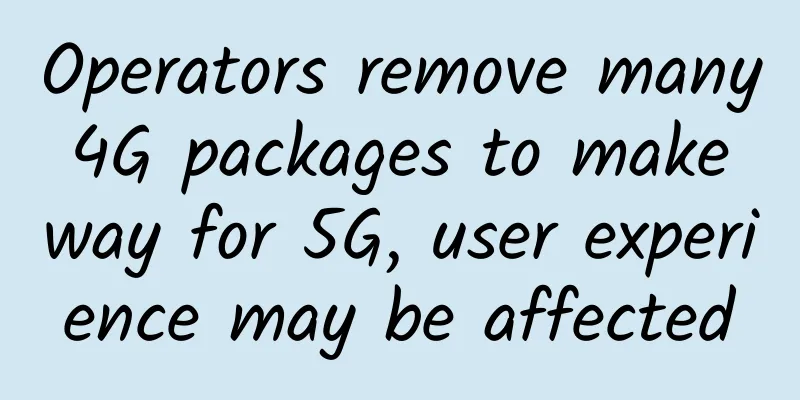An overlooked "secret weapon" in the 5G era may break the market monopoly

|
Recently, the Ministry of Industry and Information Technology issued 5G medium and low frequency test frequency use licenses to the three major operators, which gave the industry a shot in the arm. For most operators, the initial commercial use of 5G will mainly focus on enhanced mobile broadband (eMBB) scenarios. However, Verizon, an American operator that "jumped the gun" with non-standardized 5G in October this year, entered the market with fixed wireless access (FWA). While American operators are actively promoting the commercial use of FWA scenarios, there seems to be little movement in China. However, from a business perspective, FWA may be a better way to break the existing problems in the broadband field in the 5G era and further promote the development of smart homes and smart homes.
Broadband monopoly, the pain points caused by lack of selectivity For home or commercial building users, fixed wireless access (FWA) can be wirelessly connected to access devices deployed in buildings through nearby wireless base stations. These access devices are then connected to gateways or routers in each household or corporate office, realizing a wireless alternative to wired broadband. Taking the WiFi we use daily as an example, FWA can actually be said to be a wireless backhaul of the signal from the WiFi gateway or router, replacing the current backhaul through optical fiber. Although it is only a change in this small backhaul method, the author believes that it will have a greater potential impact on the existing broadband market structure, and the first thing is to break the original monopoly structure. FWA access diagram (Source: Ericsson) At present, broadband is a standard and rigid need for daily work and life for a large number of home and corporate office users. For many years, operators have spared no effort to promote fiber-optic broadband services. However, there have always been some "monopoly" problems in the entire broadband ecosystem: 1. Monopoly of residential network The monopoly of residential network in residential areas has existed for many years. The so-called residential network refers to the machine and line equipment included in the interface from the user terminal to the user network. In residential areas, it is generally the operator network interface entering the community until the door of each family. It can be said that it is the part of the optical fiber in the community. Since the operator's broadband service must pass through the residential network in the community before entering each household, the operator of the residential network charges a considerable "toll" for the access of each broadband operator to the community, and in many cases raises the entry price, excluding most operators. Only a single operator network can enter, leaving home users with only one choice. In the past ten years, due to the existence of various interest groups and property rights in the community, this kind of residential network monopoly has forced many home users to choose only one broadband service on the one hand, and the service quality cannot be guaranteed. On the other hand, it has set a high threshold for operators, resulting in extremely high costs for entering the community. 2. High-priced broadband in buildings Coincidentally, similar to the monopoly of residential network, broadband monopoly is very common in commercial buildings such as urban office buildings, and the price of enterprise broadband access remains high. The Internet of Things Think Tank of my company moved into a new office at the end of September this year. The price of broadband of the same speed in this office building is 4 times that of the original office building, and there is no other optional operator except this broadband. We may still be lucky, at least this price is barely affordable, while the price of broadband in many buildings has reached a height that small and medium-sized enterprises cannot afford. For example, the media reported that the annual fee of 50M broadband in an office building in Beijing exceeded 80,000 yuan. At the beginning of this month, the Ministry of Industry and Information Technology issued the "Notice on Rectifying the Monopoly of Broadband in Commercial Buildings and Optimizing the Development Environment of Small and Medium-sized Enterprises", requiring serious investigation and punishment of the problem of broadband monopoly in office buildings. It can be seen that the monopoly of broadband in commercial buildings has reached a very serious level. The reason why residential networks in residential areas and commercial buildings can form a broadband monopoly is that there is a distance between the operator's broadband access point and the final home and office users. This distance must be connected by a line, and the operator who connects this line to the home must leave "tolls" to the relevant parties in the community or building, otherwise it will not be able to provide services to the end users. If FWA is adopted, the operator's access point can directly reach the end user wirelessly without pulling wires into the community or building. In this way, each operator can directly provide broadband access to users fairly, and the FWA scenario formed under the 5G standard can also provide users with high-speed and stable services. The author believes that the monopoly of community or building broadband is mainly due to the fact that users have no second choice. The commercial use of FWA may not completely replace wired broadband services, but it will give users more choices to a large extent. Choices can bring competition and service improvements, which will naturally break the monopoly pattern. Cost and technology feasibility make FWA an important application scenario for 5G In fact, fixed wireless access (FWA) is not a new thing unique to 5G. It was explored as early as the 3G era. However, due to the limited bandwidth and capacity of 3G, it was not possible to provide real access. By the time 4G LTE was commercially mature, FWA had been widely used by many operators around the world. Ovum, a well-known telecommunications market research organization, released a report in September this year stating that LTE-based FWA has been proven to be able to provide continuous high-quality broadband access in a variety of usage scenarios and under different market conditions. It is expected that by 2022, LTE-based FWA services will account for more than 40% of all fixed wireless broadband users, of which 5G FWA service users will account for 16%. For operators, the large-scale commercial use of FWA requires consideration of two factors: capacity and cost. Capacity is solved at the technical level, while cost needs to be solved at the commercial level. 1. A test result to show the capacity of FWA In the documents introducing FWA, Ericsson's FWA test is frequently cited. The test results were published by Ericsson engineers in the Ericsson Technology Review. In this technical document, Ericsson conducted a test in a scenario with a population density of about 1,000 households per square kilometer, 25% of households using 4K ultra-high-definition video services, and the network speed required to be at least 15Mbps. In this scenario, if the maximum traffic demand per user per month is 5200GB, the 5G FWA network can meet the data rate of 95% of users greater than 15Mbps and the rate of 69% of users greater than 100Mbps under such a high load condition.
Network speed and user capacity provided by FWA (Source: Ericsson) Although this is just a suburban trial, it shows to some extent that 5G FWA has a large capacity and can provide broadband access that replaces wired services in some areas. Broadband services, like wireless services, also have the characteristics of economies of scale and require the number of users to reach a certain critical point, which requires technical support for high-capacity access. Previously, 3G and 4G fixed wireless access was not popular, largely because its capacity was very limited and could not achieve economies of scale. The capacity provided by 5G is 10 to 100 times that of 4G, so it has the potential to realize FWA solutions on a large scale. 2. Cost benefits are not just about saving wiring From the cost point of view, compared with fiber to the home (FTTH) and other wired solutions, the last kilometer of cabling is a tough nut to crack. Not only does it require "tolls" from the community and building stakeholders, but it also requires cabling and maintenance for the last kilometer. FWA has low construction and maintenance costs and fast deployment, and is especially suitable for households and small and medium-sized enterprises where fiber has not yet been delivered. Of course, FWA not only saves the cost of cabling entry, but also opens up a 5G application scenario for operators, and this scenario brings a higher average user value. Specifically, the current broadband service is a service with a relatively high ARPU value for operators. According to the financial reports released by operators, as of mid-2018, the comprehensive ARPU value of China Mobile's home broadband was 34.8 yuan, and that of China Telecom's home broadband was 52.5 yuan, and the comprehensive ARPU value of broadband is still rising. The commercial use of FWA can directly bring about an ARPU value that is comparable to the value of current broadband. Compared with the eRLLC and ultra-low-rate mMTC scenarios, which are still a long way from commercial use, FWA can be said to be a service with a higher average income. The value of FWA is not limited to a high ARPU value. It provides a gateway for telecom operators to innovate other services. Through the FWA gateway, high-definition video and VR/AR entertainment scenarios in the home can largely give eMBB a chance to land. In addition, we have noticed that the home broadband services currently provided by telecom operators focus more on comprehensive broadband revenue. For example, China Mobile's innovative smart home services such as "Magic Lily" and smart gateways derived from home broadband provide more room for operators to innovate in the smart home field when broadband access is achieved through FWA. Of course, FWA provides a choice, not a replacement. The three major domestic operators are very active in the 5G field, but rarely invest in and explore FWA. In my opinion, FWA can provide users with a means of choice in the future 5G market, but it is impossible to replace wired broadband. From the above capacity test, we can see that although the capacity of 5G is more than 10 times higher than that of 4G, FWA still cannot support high-capacity access. In Ericsson's test project, there are 1,000 users in 1 square kilometer. However, in a large number of urban environments, the user density is much higher than this number. Take the community where the author lives as an example. The area of the community is only 0.1 square kilometers, but the number of residents in the community is close to 1,000. This is just a community in Shunyi District, which is relatively remote in Beijing. If it is in the residential community in the main urban area, the density is believed to be higher, and users often use broadband in the evening, which may cause wireless congestion. Therefore, in high-density urban areas, FWA cannot provide a smooth uplink and downlink experience like wired broadband.
However, in some relatively remote areas such as suburbs and rural areas, where the cost of laying optical fiber is high and the household density is not high, FWA may be a better way. Operators can provide broadband access services to users in these areas at a low cost and expand some high ARPU value users. When the number of users in these areas reaches the critical point of FWA deployment cost, operators are still motivated to deploy and provide services. Of course, although FWA cannot replace wired broadband in cities, it does not affect its commercial use in cities. Before the number of users reaches the capacity limit, FWA provides a choice for users in residential areas and office buildings. This choice is conducive to reducing the monopoly price of broadband in residential areas and buildings, so that wired broadband and FWA can reach a relatively reasonable and balanced pricing system. At the same time, the three major operators have already achieved broadband access in most residential areas in major cities. These have already paid sunk costs in the early stage. If they deploy FWA, they will further promote their bargaining chips with local network operators to reduce "tolls"; for those operators that have not yet settled in some residential areas or buildings, FWA also provides them with a low-cost and fast means to "poach" competitors' users. When users have a variety of choices and the costs and services of various choices are not very different, all types of access methods are used by users, and it is impossible for all to choose FWA and cause insufficient capacity. As a pioneer, Verizon's FWA service 5GHome mainly provides this service outside its traditional fixed network coverage. Currently, Verizon is the fourth largest broadband service provider in the United States, with a market share of 6%. Through FWA, it may be able to form a first-mover advantage in the potential market of 30 million households in the United States in a short period of time. Getting ahead of the curve in 5G and being the first to commercialize FWA are Verizon's thinking and practice on the initial scale of 5G. Faced with the high investment in 5G and the unclear application scenarios, can this move give other market participants a revelation? Breaking the monopoly, increasing the number of connections and ARPU value, and promoting smart home innovation, FWA may be a scenario that has been overlooked by 5G, but it is a scenario that brings large-scale applications to the initial commercialization of 5G. |
<<: The past and present of IPv6 and the comparison with IPv4
>>: 2018 Yunnan-Huawei Software Industry Summit was held on December 20
Recommend
Amid COVID-19, have we neglected border security?
[[342703]] The coronavirus pandemic has triggered...
Blockchain makes cities smarter and more innovative
This article takes stock of the smart city applic...
What problems do HTTP/1, HTTP/2, and HTTP/3 solve?
What problems does each generation of HTTP solve?...
Krypt: iONcloud cloud platform Halloween 15% off, San Jose/Los Angeles/Dallas/Honolulu data centers
The last time the tribe shared information about ...
LOCVPS Double 11 20% off all VPS, top up 300 yuan and get 50 yuan, top up 600 yuan and get 150 yuan
LOCVPS launched the Double 11 promotion on the 19...
5G network is accelerating! More than 500,000 5G base stations have been built and put into operation across the country
Since the 13th Five-Year Plan, my country has vig...
[11.11] UUUVPS US VPS annual payment starts from 91 yuan, Hong Kong CN2 annual payment starts from 182 yuan
UUUVPS (Sanyou Cloud) launched the promotion duri...
Why does TCP need three handshakes and four waves?
[[402116]] This article is reprinted from the WeC...
To accelerate 5G innovation and monetization, Ericsson and several operators jointly established a network API company
According to foreign media reports, communication...
5G has been commercially available for a year. Can consumers still buy 4G mobile phones?
5G has been in commercial use for more than a yea...
Huawei's IP production and broadcasting network solutions continue to innovate, helping television enter the ultra-high-definition era
Today is World Television Day. Do you remember th...
Is it safe to use HTTPS? What is the principle of HTTPS?
HTTPS As the cost of building a HTTPS website dec...
100 basic network knowledge popularization, read it to complete half of the network master
This article is about popularizing 100 basic netw...
What are the unique values of enterprise-level Wi-Fi Mesh networks?
Wi-Fi introduced mesh technology very early, and ...
3 Reasons Your IoT Needs SD-WAN
We live in an era of fast-paced digital transform...

![[11.11] Hostons: VPS hosting annual payment free double hard disk + double traffic](/upload/images/67cac236432b4.webp)







